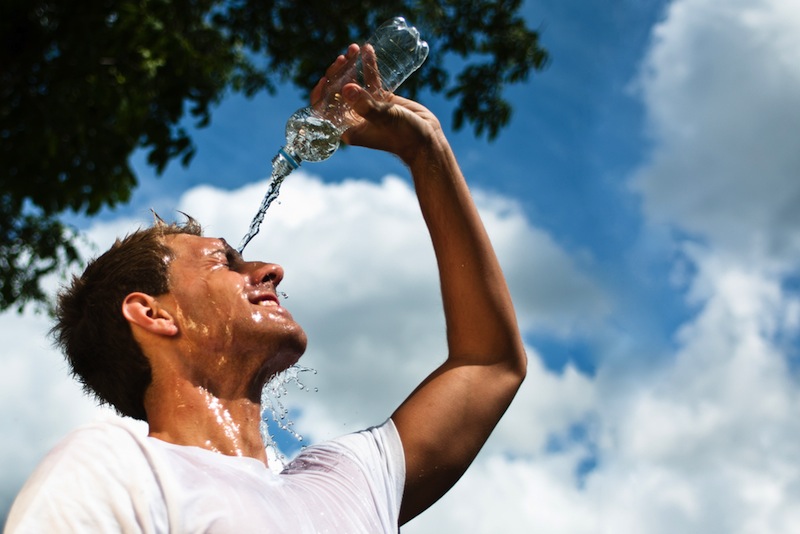Roasting? 7 Scientific Ways to Beat the Heat

Sweltering summer days aren't just oppressive and uncomfortable; they can be lethal, if the body's core temperature climbs much beyond 104 degrees Fahrenheit (40 degrees Celsius).
Scientists studying people working under super-hot conditions — think firefighters, foundry workers and soldiers marching with fully loaded packs — have learned a lot about how the body handles heat. Beyond the basic advice of staying hydrated while avoiding sugary drinks, caffeine and alcohol, here are some evidence-based strategies for coping with our overheating world.
Get used to it
"Humans have a tremendous ability to acclimatize to heat stress," says Michael Sawka, a professor at Georgia Institute of Technology in Atlanta, who studies how humans adapt to extreme conditions. "You acclimate to what you're exposed to."
But this doesn't have to mean hours of misery under the broiling sun. Spending just 100 minutes a day outside over four to 10 days is enough, to help your body adjust to functioning in warmer weather, Sawka says.
Be in shape
Being aerobically fit increases your ability to handle heat. "Training induces a lot of the characteristics that you typically see in somebody that is actually heat-acclimated," said Heather Wright, a research officer in the Flight Research Lab at the National Research Council Canada in Ottawa, who studies the effect of heat and other stresses on the body.
Sign up for the Live Science daily newsletter now
Get the world’s most fascinating discoveries delivered straight to your inbox.
A workout is like a mini-session of heat stress, she said. "With heat acclimation as well as with training, your resting core temperature decreases," Wright said. "As your temperature increases with exertion, heat and that sort of thing, it takes a longer period of time before your temperature reaches high levels, which are of concern."
Go for the green
As anyone who's emerged from an air-conditioned car to set foot on sticky-hot asphalt can attest, "heat islands" are a real thing. Under the blazing sun, roofs and pavement can reach temperatures from 50 to 90 F (10 to 32 C) higher than the air temperature, according to the Environmental Protection Agency, which has a website dedicated to helping communities address heat island effects.
For your own personal heat island escape, head for any patch of green you see, ideally one with some trees for shade. Plants not only block sun; they act like living air conditioners. "When the plant takes moisture up from the soil and exhales it through the leaves, you have evaporative cooling," explained Stan Cox, a plant breeder at the Land Institute in Salina, Kansas, and author of "Losing Our Cool: Uncomfortable Truths About Our Air-Conditioned World" (2012, The New Press).
Take a rest
Feeling overheated? Not only should you head for the shade or an air-conditioned room, but also you should spend longer there than you think you need to, Wright said. "It does actually take a while for your core temperature to start to decrease," she said. "Short breaks are usually not going to be enough to make a difference."
That's because even after you're out of the heat, your core temperature will keep inching up before it goes back down. When you're feeling the effects of heat stress, regular breaks that are at least 15 minutes long are needed to reduce the increases in body temperature and cardiovascular strain, Wright said. Try to get to a cool or shaded area and allow time for your breathing and heart rate to slow to normal.
Leave your sweat on your skin
The human body has evolved to cope with heat by sending more blood to the surface of the skin to dissipate heat, and by sweating. Both of these processes become more efficient in fit people and with heat acclimation. To take full advantage of these built-in systems, don't wipe off sweat, but allow it to evaporate from your skin and cool you down, Sawka said.
If you need a fast cool-down, plunge your arms into cold water up to the elbows, Sawka said. This trick — used often by firefighters and overheated military personnel — works to pull heat out of your body efficiently because your forearms have a high surface-area-to-volume ratio.
Switch out light bulbs, and unplug
Even a single incandescent bulb can generate a significant amount of heat. Per hour, a regular light bulb gives off 85 British thermal units of heat (one BTU is the amount of energy needed to heat 1 lb. of water by 1 degree F). For comparison, compact fluorescent lights give off 30 BTUs per hour, and light-emitting diodes give off just 3.4 BTUs per hour.
Devices from computers to TVs to smartphones are also potent heat sources, so shut them off and unplug them if they aren't in use.
Get passive-cooling aggressive
A host of approaches can help you cool down your environment while using little or no energy, Cox said. People can put shades on south-facing windows, open windows at night to let cooler air flow in and close them in the morning before the day heats up, and strategically use open windows and box fans to keep air circulating, he said.
Embrace public spaces
Air conditioning may hog electricity, but it does boost human productivity. Several studies have shown that workers' energy drags as the temperature climbs. And nothing beats AC for coping with oppressive humidity, Cox said.
Those who need to get some serious work done on a torrid day might search out a public library or coffee shop, where the cool environment will help you crank it out — and leave you more time for summer fun when you're done.
Follow LiveScience @livescience, Facebook & Google+. Originally published on Live Science.










